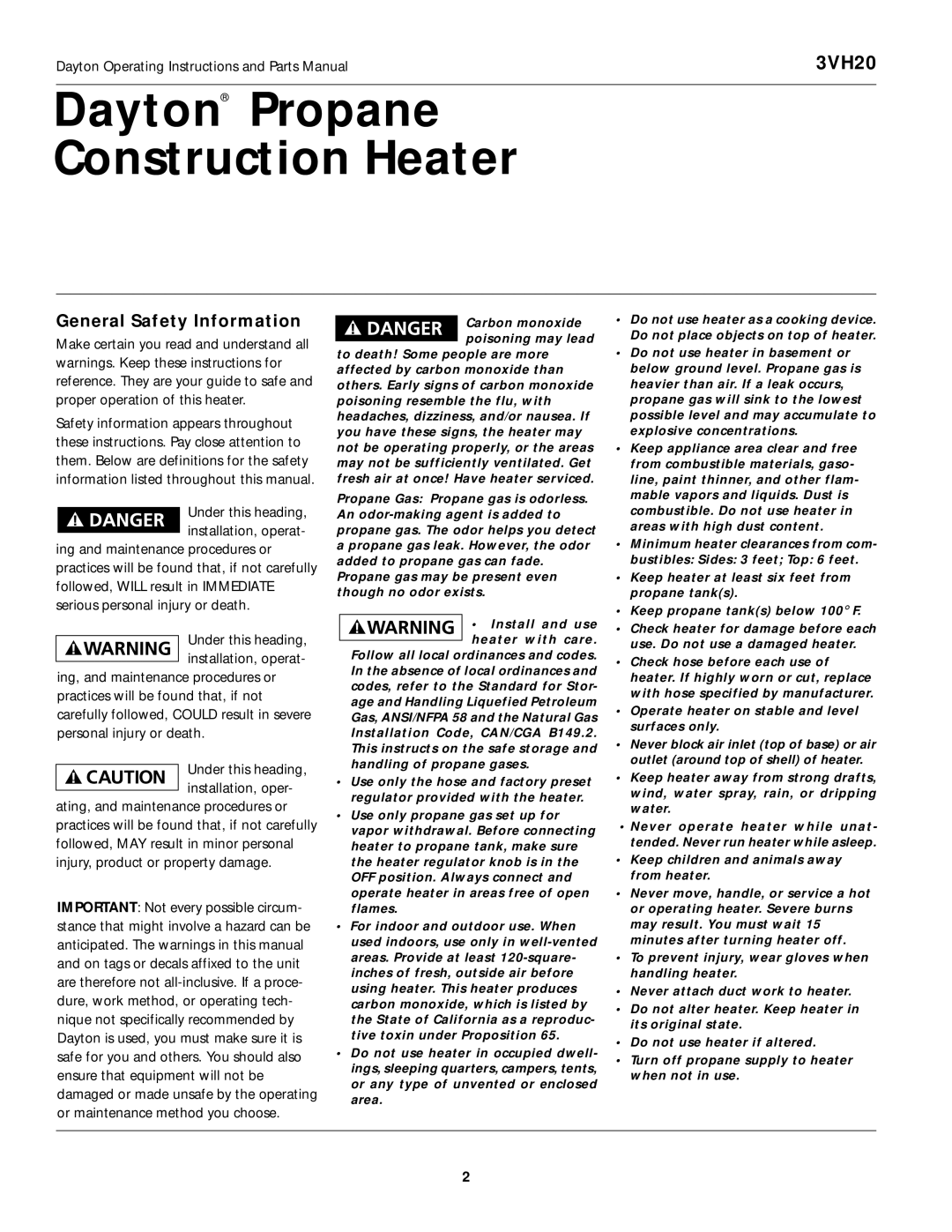
Dayton Operating Instructions and Parts Manual | 3VH20 |
Dayton® Propane
Construction Heater
General Safety Information
Make certain you read and understand all warnings. Keep these instructions for reference. They are your guide to safe and proper operation of this heater.
Safety information appears throughout these instructions. Pay close attention to them. Below are definitions for the safety information listed throughout this manual.
Under this heading, installation, operat-
ing and maintenance procedures or practices will be found that, if not carefully followed, WILL result in IMMEDIATE serious personal injury or death.
Under this heading, installation, operat-
ing, and maintenance procedures or practices will be found that, if not carefully followed, COULD result in severe personal injury or death.
Under this heading, installation, oper-
ating, and maintenance procedures or practices will be found that, if not carefully followed, MAY result in minor personal injury, product or property damage.
IMPORTANT: Not every possible circum- stance that might involve a hazard can be anticipated. The warnings in this manual and on tags or decals affixed to the unit are therefore not
Carbon monoxide poisoning may lead
to death! Some people are more affected by carbon monoxide than others. Early signs of carbon monoxide poisoning resemble the flu, with headaches, dizziness, and/or nausea. If you have these signs, the heater may not be operating properly, or the areas may not be sufficiently ventilated. Get fresh air at once! Have heater serviced.
Propane Gas: Propane gas is odorless. An
• Install and use heater with care.
Follow all local ordinances and codes. In the absence of local ordinances and codes, refer to the Standard for Stor- age and Handling Liquefied Petroleum Gas, ANSI/NFPA 58 and the Natural Gas Installation Code, CAN/CGA B149.2. This instructs on the safe storage and handling of propane gases.
•Use only the hose and factory preset regulator provided with the heater.
•Use only propane gas set up for vapor withdrawal. Before connecting heater to propane tank, make sure the heater regulator knob is in the OFF position. Always connect and operate heater in areas free of open flames.
•For indoor and outdoor use. When used indoors, use only in
•Do not use heater in occupied dwell- ings, sleeping quarters, campers, tents, or any type of unvented or enclosed area.
•Do not use heater as a cooking device. Do not place objects on top of heater.
•Do not use heater in basement or below ground level. Propane gas is heavier than air. If a leak occurs, propane gas will sink to the lowest possible level and may accumulate to explosive concentrations.
•Keep appliance area clear and free from combustible materials, gaso- line, paint thinner, and other flam- mable vapors and liquids. Dust is combustible. Do not use heater in areas with high dust content.
•Minimum heater clearances from com- bustibles: Sides: 3 feet; Top: 6 feet.
•Keep heater at least six feet from propane tank(s).
•Keep propane tank(s) below 100° F.
•Check heater for damage before each use. Do not use a damaged heater.
•Check hose before each use of heater. If highly worn or cut, replace with hose specified by manufacturer.
•Operate heater on stable and level surfaces only.
•Never block air inlet (top of base) or air outlet (around top of shell) of heater.
•Keep heater away from strong drafts, wind, water spray, rain, or dripping water.
•Never operate heater while unat- tended. Never run heater while asleep.
•Keep children and animals away from heater.
•Never move, handle, or service a hot or operating heater. Severe burns may result. You must wait 15 minutes after turning heater off.
•To prevent injury, wear gloves when handling heater.
•Never attach duct work to heater.
•Do not alter heater. Keep heater in its original state.
•Do not use heater if altered.
•Turn off propane supply to heater when not in use.
2
